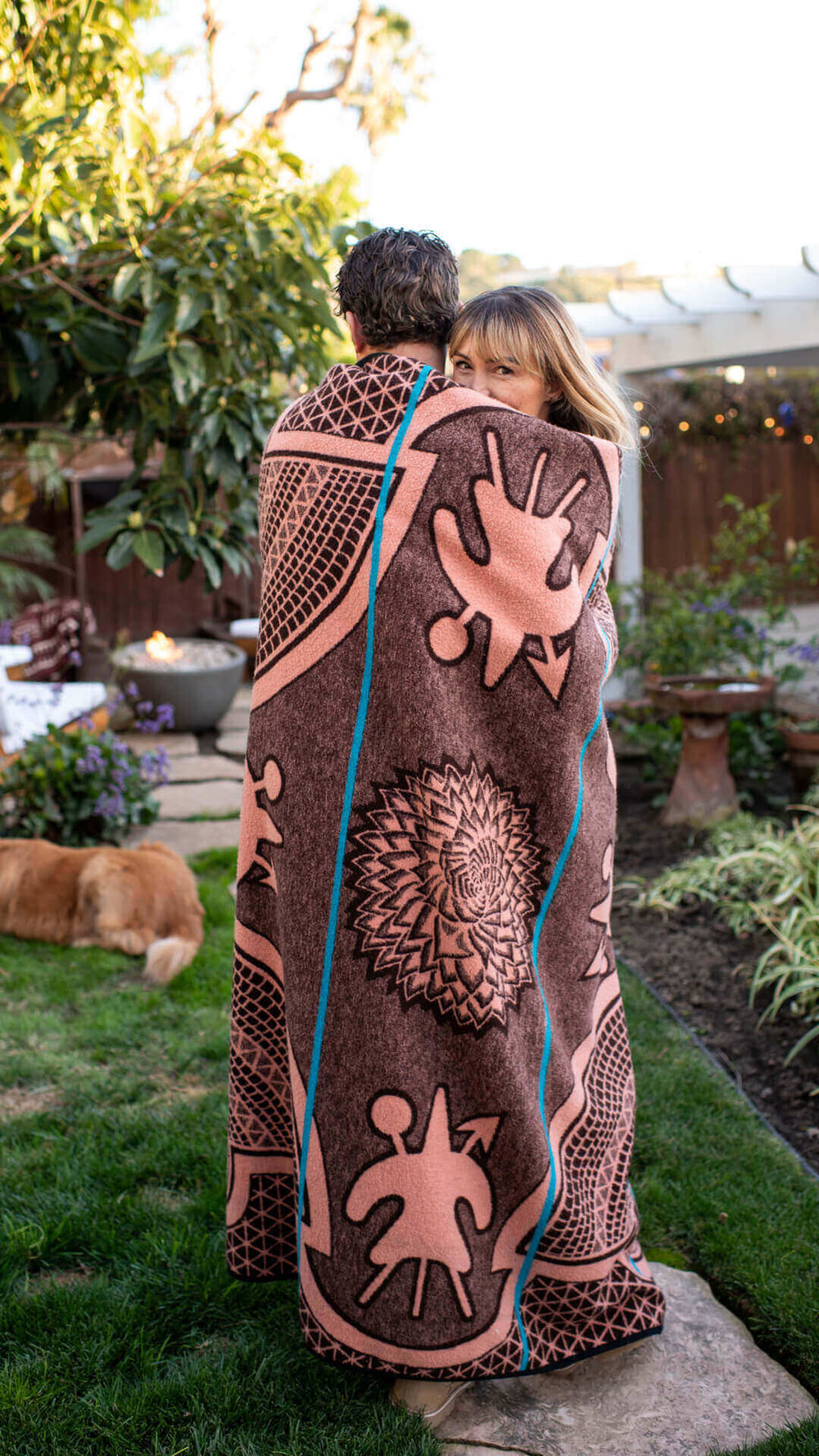Your Cart is Empty
FREE u.s shipping over $250
FREE u.s shipping over $250
shop
Wedding Blankets: A Perfect Gift for Your Special Day
6 min read

What's in this article
Looking for the perfect wedding blanket? Look no further! This ultimate guide will help you choose the perfect blanket for your special day.
Wedding ceremonies signify the creation of new families, and wedding blankets are the ideal timeless gift that carries the meaningful message of sharing, among other significant and heartfelt messages wrapped into the gift of a wedding blanket.
The gift of blankets on special occasions like weddings, births, coming-of-age ceremonies, and much more has been entwined into cultural traditions worldwide for centuries. Throughout recorded history, blankets as gifts have been part of most cultures.
The meaning and significance of gifting a special blanket to a couple on their wedding day are universal across different cultures and nations, but each culture remains unique. This reflects what it means to be human.
Let's go back into history and discover why some prominent nations find significance in gifting wedding blankets.

Symbolism in Wedding Blankets
Wedding blankets, a beautiful and time-honored tradition, have long served as a symbol of love, unity, and warmth for newlywed couples. These intricately woven and embroidered blankets are visually stunning and deeply culturally significant.
Wedding blankets often incorporate symbols and motifs that hold deep meaning for the couple and their families. Among the more universal symbols are love, unity, fertility, protection, and prosperity.
- Love: Hearts, intertwined vines, and floral patterns are common symbols of love in wedding blankets. These elements are often featured prominently in the design to celebrate the love the newlywed's share.
- Unity: Geometric patterns, such as interlocking squares, diamonds, or circles, represent the coming together of two individuals to form a new, unified partnership.
- Fertility: In many cultures, fertility is essential to a successful marriage. Motifs such as seeds, plants, and flowers can be found in wedding blankets to symbolize growth and hope for future generations.
- Protection: Wedding blankets often incorporate protective symbols, such as the "Hand of Fatima" or other religious symbolism, to shield the couple from harm and ward off negative energies.
- Prosperity: Symbols of wealth, abundance, and good fortune are often woven or embroidered into wedding blankets. These can include coins, animals, or other symbols associated with prosperity.
You'll find that these common symbolic wedding wishes are portrayed in different cultures that have primarily created and not adopted their cultural practices.

Handira Wedding Blankets from Morocco, North Africa
Wedding blankets in Morocco are known as Handira and stem from the High Atlas Mountain regions. Handira blankets have been essential to Berber weddings for centuries and are usually crafted by the bride's female relatives.
Handira wedding blankets feature intricate patterns handwoven from wool with clusters of sequins and tufts of cotton finished with artfully woven kilim Berber bands. They are believed to bring good luck, fertility, and protection from evil spirits.
These intricately crafted blankets were once worn by a Bride as a cape, draped over her shoulders, during the wedding procession. In contemporary times, they are a sought-after cover for interior design styling.

Wedding blanket of the Sikhs in Punjab, India
In early history, the groom's family would embark on a journey to the bride's family village, which may have taken several days and much planning. Women were forbidden from partaking in the journey and subsequent ceremony of the meeting of the two families as it was deemed an omen that would bring bad luck.
The traveling group is called the "baraati." Upon arrival at the bride's village, the groom's father is presented with a blanket. This significant gesture is made with the utmost respect, and some money is placed underneath the blanket.
The blanket represents honor, respect, love, caring, protection, warmth, and comfort, a silent message from the bride's father. He will state that his daughter represents all these virtues of his home, and from today onwards, he presents this Bundle of Love to the groom's father and his family!"
The groom's father accepts the blanket, and the money is returned to the bride's father in a gesture that would silently state, "She is worth more than this." In this way, a sense of promise is conveyed that every care shall be given to her in every possible way.
The blanket represents the sacrifice of the Sikh's 9th Guru Sahib, Guru Teg Bahadur Ji. He is titled Hind-Ki-Chaddar, meaning "The Blanket of Hindustan." The blanket commemorates love, care, and comfort, which signifies the unification of two families.
Suek Punjab wedding costs are primarily split 50/50 between the two families. But if one side insists on more guests or extra fanfare, the costs are adjusted accordingly.
Another fascinating tradition is the making of the phulkari, which translates to "flower work." Phulkari is an embroidered textile with an elaborate and colorful floral pattern.
Originating from the Punjab region, phulkari is traditionally hand-embroidered by the bride's female relatives using silk thread on a coarse cotton base. Phulkari's are believed to symbolize prosperity and happiness and are often gifted to the bride during her wedding ceremony.

Wedding blanket ceremony of the Native American
At a Native American wedding ceremony, the bride and groom are each wrapped in separate blue blankets. Once the officiant blesses and removes the blue blankets, the couple is wrapped in a single white blanket.
Blue blankets represent their past single lives, while the white blanket represents their new life as a family filled with peace and happiness. The white blanket is kept by the couple and displayed in their home. This simple ceremonial ritual clearly symbolizes unity and commitment.
Blanket gift-giving acknowledges a relationship that reflects the honor, respect, and recognition of an individual's changed social status or achievements.
In the United States, wedding quilts have been a cherished tradition since the country's early days. These handcrafted quilts, often made by the bride's family and friends, feature patchwork designs that incorporate various fabrics, colors, and patterns.
American wedding quilts symbolize the love and support the couple receives from their community.

Wedding blankets in Mexico
In Mexico, the tradition of wedding blankets, or "cobijas de boda," began with the indigenous Otomí people. These blankets are hand-embroidered with vibrant, geometric patterns that represent the joining of two lives. They are typically made from wool or cotton, symbolizing the couple's unity and warmth.
To add, the storytelling patterns of Mexican tenango designs bring the rich, artistic history of Mexican culture to weddings. Tenango is a traditional Mexican embroidered fabric created by the Otomí Indians from Tenango, Hidalgo.
With saturated colors and graphic floral and animal patterns, contemporary tenango designs present a striking example of modern ingenuity merged with ancient tradition. Tenango fabrics can make tablecloths, pillows, upholstered furniture, lampshades, napkins, table runners, and blankets.

Wedding blankets of the Basotho people of Lesotho, Southern Africa
Basotho heritage blankets have deep cultural significance to the Basotho nation. They are a strong expression of Basotho virtues, status, and unity. Basotho blankets are worn daily as part of the Basotho traditional dress code.
The Poone blanket design emphasizes the corncob or mealie, symbolizing growth and fertility, and is often gifted at wedding ceremonies. Poone means "to swear by the Chiefs," Its tight, thick weave is soft and warm, ideal for the mountainous Kingdom of Lesotho.
As a gesture of union, the groom will present his bride with a wedding blanket. The blanket may also form part of "bohali," the gifts given to the bride's parents as part of the agreement or union of marriage between families.
The motto "Kobo ke bophelo" is entrenched in the nation, meaning "The blanket is life." A young bride will wear a blanket wrapped around her hips to stay warm, typically associated with fertilization.

Chinese Wedding Quilts
Chinese wedding quilts, known as "xiuju" or "xiupei," have long been a part of traditional Chinese wedding customs. These elaborately embroidered silk quilts often feature auspicious symbols, such as the dragon and phoenix, representing the balance of male and female energies. Chinese wedding quilts are believed to bring good luck, harmony, and prosperity to the couple.

Modern Interpretations and Adaptations
In recent years, wedding blankets have experienced a resurgence in popularity thanks to their unique blend of tradition, craftsmanship, and modern design. Couples have started incorporating these blankets into their wedding ceremonies and celebrations in various ways:
- As a ceremonial backdrop: A wedding blanket can serve as a stunning backdrop for the couple's vows or as a focal point during the wedding reception. This adds a touch of cultural heritage and creates a visually striking and memorable setting.
- As a guest book: Couples can invite their guests to write their good wishes on a wedding blanket instead of using a traditional guest book. This creates a unique and sentimental keepsake that can be displayed in the couple's home for years to come.
- As a gift for the couple: Wedding blankets make for a thoughtful and meaningful gift for newlyweds.
Wearing and gifting blankets on special occasions, particularly weddings, has been part of many cultures and is a growing trend in modern society. The significance of a well-made warm, durable blanket will find a place in every newly created family.
They are often passed down as heirlooms through generations and are cherished by families worldwide. Gifting a beautiful blanket as a wedding gift is truly a gift worth giving.












